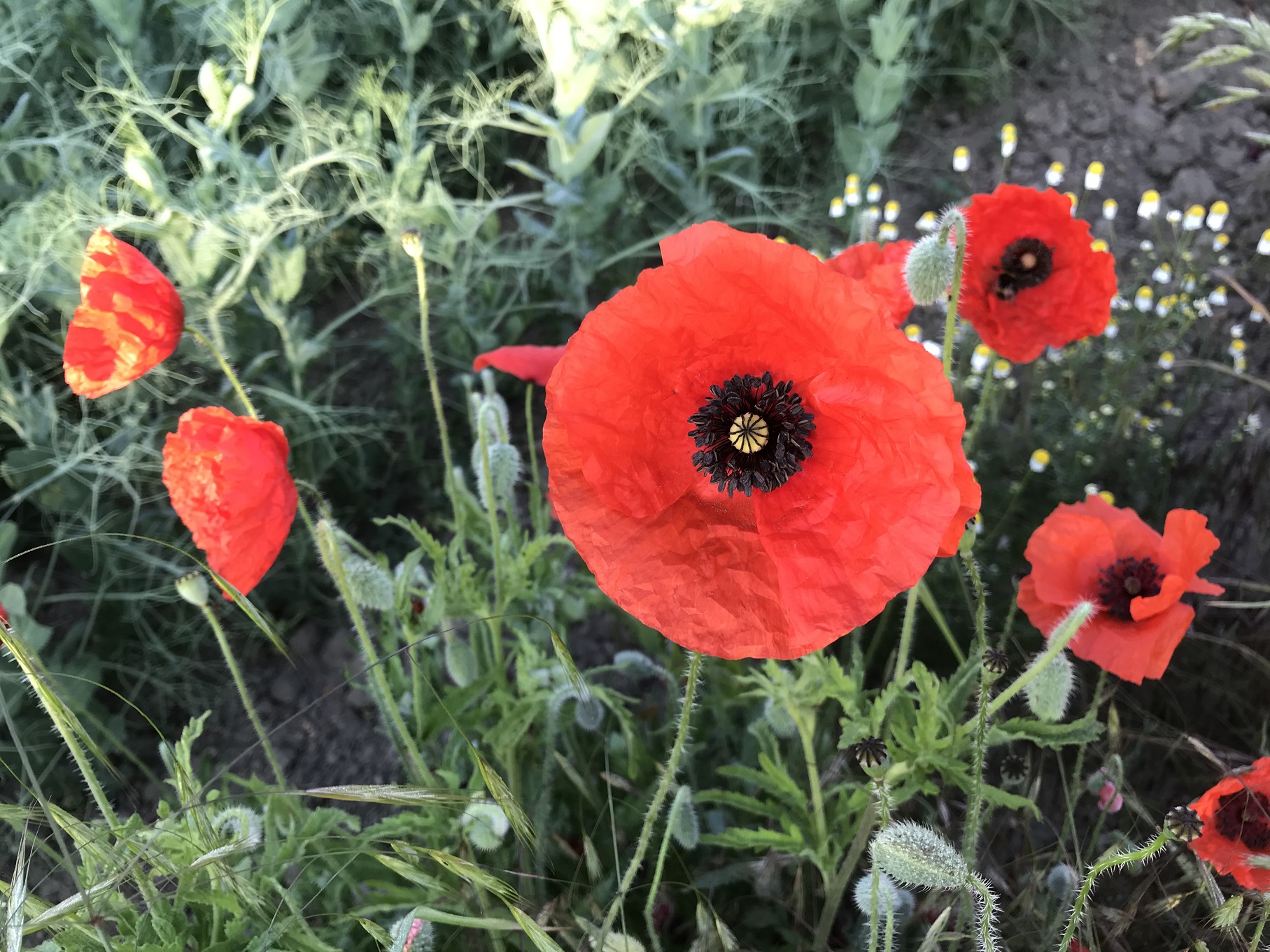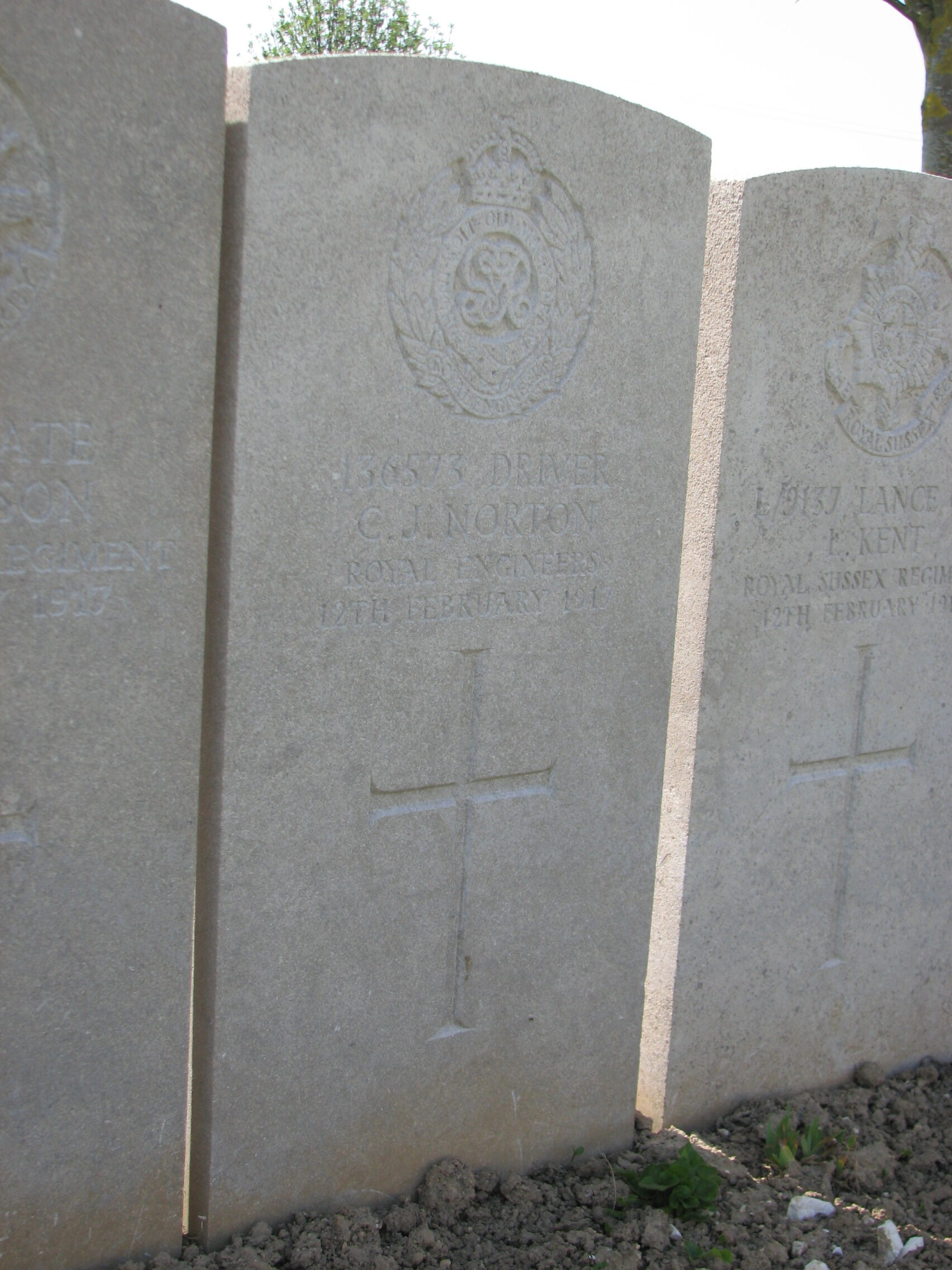Caleb Norton (1891 - 1917)
Caleb served as a Driver (of horses) with the Royal Engineers on the Western Front. He died in France in February 1917, leaving a wife and infant daughter.
- 49
- Died in the Great War
- 51.989649, 1.020955
Details
| Name: | Caleb Joseph Goddard Norton |
| Service: | British Army |
| Unit: | 15th Field Company, Royal Engineers |
| Regimental Number: | 136573 |
| Rank: | Driver |
| Date of Death: | 12th February 1917 |
| Age: | 25 |
| Buried: | Plot II, Row A, Grave 40, Bray Military Cemetery, near Albert, France |
Family Background and Early Life
Caleb Norton was born in East Bergholt on 8th June 1891, quite possibly at his grandparents’ house at Lattinford. Caleb’s mother, Rose Norton was a Domestic Servant, who was only 16 or 17 when he was born.
Caleb appears to have been brought up by his grandparents, Harry and Elizabeth Norton, and raised as their son, a situation that was quite common in similar circumstances at that time. Harry was an Agricultural Labourer from Capel St. Mary. He had married Elizabeth Double from Great Wenham in 1873, about the time that they moved to East Bergholt.
Caleb’s schooling started at Holton School before he moved to East Bergholt School – at that time located at Burnt Oak Corner – in October 1897. He remained a pupil there until his fourteenth birthday.
After leaving school, Caleb found employment as a Farm Labourer.
In 1898, Caleb’s mother married a man called Arthur Sutton in Lambeth, presumably having lived there for a time. She went on to have further children.
Both the 1901 Census and the 1911 Census show Caleb staying with his Great Grandfather, John Norton who lived next door to Harry and Elizabeth.
Marriage and a Daughter
On 1st June 1914 at St Margaret’s Church at Capel St. Mary, Caleb married Emily Ambrose. Emily was two years Caleb’s junior and had been born and raised at Little Wenham, where her father was a Blacksmith.
The couple lived at Lattinford, and it was there on 21st April 1915, that Emily gave birth to their daughter. Caleb and Emily named the little girl Constance Muriel.
It appears that Caleb joined the Army in late 1915, possibly under the Group Scheme. This was effectively a last ditch attempt by the government to increase recruitment by voluntary means, before they had to resort to conscription. 1 Often called the Derby Scheme, after the Director-General of Recruiting. It permitted a man to enlist and then – if he chose to – be immediately transferred temporarily to the Army Reserve and go back to his civilian occupation until he was formally required. The evidence suggests that Caleb chose not to take this option, but instead opted for immediate service.
France
Caleb was sent to France in late May 1916. 2 On 17th May 1916, whilst he was at Aldershot, Caleb completed a Will. It is interesting to note that Emily’s address on the Will is given as “the Bridge, Little Wenham”. After a short period at a Base Depot near the city of Rouen, he joined the 15th Field Company “in the field” on 30th May 1916.
The Field Companies were units of the Royal Engineers that were attached to an Army Divison, in order to provide them with a source of trained engineers to undertake or oversee tasks. 3 The tasks of the Royal Engineers Field Companies included: Construction of dugouts, aid posts, concrete bunkers, duckboard pathways, field defences including wiring and digging trenches (or more likely supervising the infantry doing this). They also built bridges – and if the need arose – demolished them. Almost all members of a Field Company were armed as infantrymen, and occasionally – if required – they could be called upon to fight.
The Field Companies relied on horses for transport, and their importance is underlined by the fact that almost a quarter of a Company’s men were – like Caleb – not engineers, but Drivers. 4 On paper at least, a Field Company had an establishment of 217 men, 50 draught heavy horses, 17 riding horses and 4 pack horses, with a further 5 draught horses in reserve as replacements.
At the time that Caleb joined the 15th Field Company they were based in or near the town of Albert on the Somme. At the end of May 1916, this was still a comparatively quiet sector in terms of fighting.
All that would change just over a month later, when on 1st July 1916, it was to see the launch of the biggest Anglo-French offensive of the War to that date. History knows this offensive as the Battle of the Somme.
The 15th remained on the Somme until the middle of July, when they were then sent north to work in the sectors of the front near the town of Bethune.
They returned to the Somme in mid-October with the Battle still raging. The Battle of the Somme officially ended on 18 November 1916, and at the end of that month the 15th Field Company were sent to the rear.
After spending most of the next two months engaged in various tasks in the rear areas, the Field Company again returned to the Somme in late January of 1917.
Less than 3 weeks later – on 12th February 1917 – Caleb died from acute Bronchitis at the 48th Casualty Clearing Station in the village of Bray-sur-Somme. 5 For many of the men who served in the Great War, the rigours of active service often in cold, wet and unsanitary conditions made them more susceptible to disease and illness. The human respiratory system was all the more vulnerable if a man may have been exposed to even a small amount of poison gas.
Caleb was buried in the nearby Bray Military Cemetery. It is now the last resting place of 874 Commonwealth service personal who died in the Great War.
Postscript
Emily Norton remarried after the War and is believed to have passed away in 1977.
Copyright © Mark Ashmore, 2024
- 49
- Died in the Great War
- 51.989649, 1.020955



